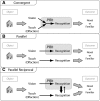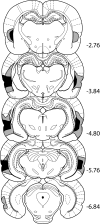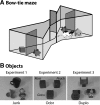Separate but interacting recognition memory systems for different senses: the role of the rat perirhinal cortex
- PMID: 21685150
- PMCID: PMC3125609
- DOI: 10.1101/lm.2132911
Separate but interacting recognition memory systems for different senses: the role of the rat perirhinal cortex
Abstract
Two different models (convergent and parallel) potentially describe how recognition memory, the ability to detect the re-occurrence of a stimulus, is organized across different senses. To contrast these two models, rats with or without perirhinal cortex lesions were compared across various conditions that controlled available information from specific sensory modalities. Intact rats not only showed visual, tactile, and olfactory recognition, but also overcame changes in the types of sensory information available between object sampling and subsequent object recognition, e.g., between sampling in the light and recognition in the dark, or vice versa. Perirhinal lesions severely impaired object recognition whenever visual cues were available, but spared olfactory recognition and tactile-based object recognition when tested in the dark. The perirhinal lesions also blocked the ability to recognize an object sampled in the light and then tested for recognition in the dark, or vice versa. The findings reveal parallel recognition systems for different senses reliant on distinct brain areas, e.g., perirhinal cortex for vision, but also show that: (1) recognition memory for multisensory stimuli involves competition between sensory systems and (2) perirhinal cortex lesions produce a bias to rely on vision, despite the presence of intact recognition memory systems serving other senses.
Figures







References
-
- Aggleton JP, Keen S, Warburton EC, Bussey TJ 1997. Extensive cytotoxic lesions of the rhinal cortices impair recognition but spare spatial alternation in the rat. Brain Res Bull 43: 279–287 - PubMed
-
- Brown MW, Aggleton JP 2001. Recognition memory: What are the roles of the perirhinal cortex and hippocampus? Nat Rev Neurosci 2: 51–61 - PubMed
-
- Bucci DJ, Saddoris MP, Burwell RD 2002. Contextual fear discrimination is impaired by damage to the postrhinal or perirhinal cortex. Behav Neurosci 116: 479–488 - PubMed
Publication types
MeSH terms
Substances
Grants and funding
LinkOut - more resources
Full Text Sources
